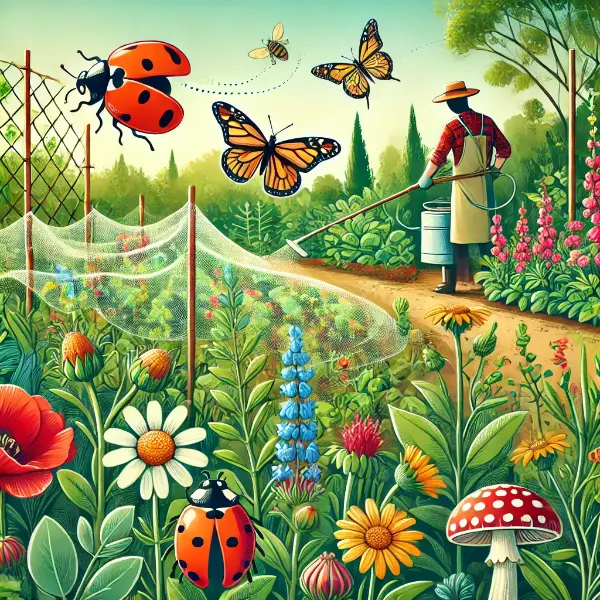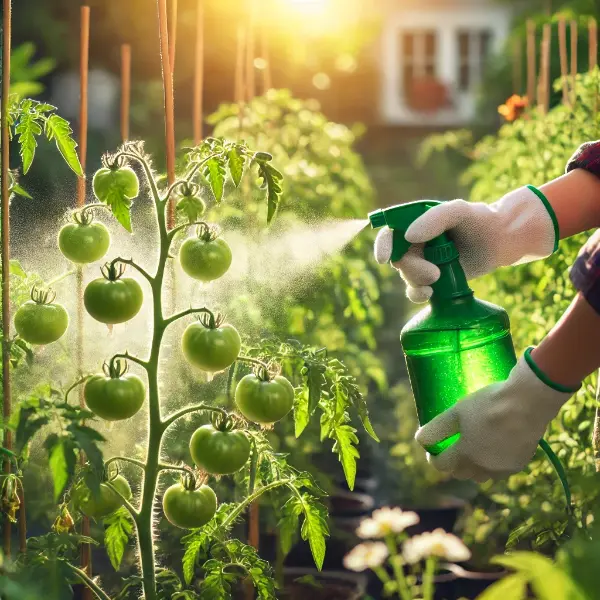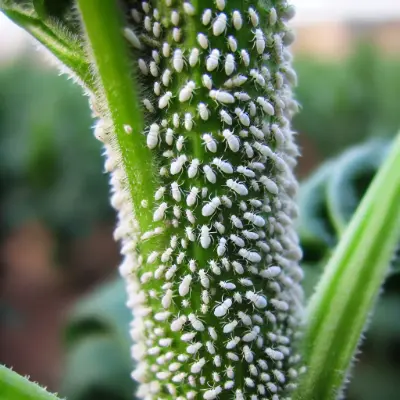
In recent years, there has been a growing interest in natural pest control methods due to increasing concerns about the environmental and health impacts of chemical pesticides. Natural pest control offers a safer, more sustainable alternative for managing pests in gardens, homes, and agricultural settings. This comprehensive guide will introduce you to the basics of natural pest control, its benefits, and various methods you can use to protect your plants and environment.
What is Natural Pest Control?

Definition: Natural pest control refers to the use of organic and environmentally friendly methods to manage pest populations. Unlike chemical pesticides, which often have harmful side effects, natural pest control methods aim to reduce pests while minimizing damage to the ecosystem.
Comparison: Chemical pest control relies on synthetic chemicals to kill pests. While effective, these chemicals can harm beneficial insects, contaminate soil and water, and pose health risks to humans and animals. In contrast, natural pest control methods use biological, botanical, cultural, and physical approaches to manage pests without these negative side effects.
Benefits
- Environmental Safety: Natural pest control methods offer significant benefits to the environment compared to conventional chemical pesticides. By utilizing organic and non-toxic substances, these methods ensure that no harmful residues are left in the soil, water, or air, promoting a healthier ecosystem.
- Soil Health:
- Preservation of Soil Microorganisms: Natural pest control methods help preserve the beneficial microorganisms in the soil that are crucial for plant health and nutrient cycling. Chemical pesticides often kill these microorganisms, leading to degraded soil health over time.
- Soil Structure: Organic pest control methods, such as compost and natural predators, enhance soil structure and fertility, ensuring long-term sustainability of agricultural practices.
- Water Quality:
- Prevention of Water Pollution: Chemical pesticides can leach into groundwater or run off into rivers and lakes, causing significant water pollution. Natural pest control methods eliminate this risk, ensuring clean and safe water for drinking, irrigation, and wildlife.
- Aquatic Life Protection: Many chemical pesticides are toxic to aquatic life, disrupting ecosystems in rivers, lakes, and oceans. Natural pest control methods are safe for aquatic environments, protecting fish, amphibians, and other aquatic organisms.
- Wildlife Safety:
- Non-Toxic to Beneficial Insects: Natural pest control methods target harmful pests without affecting beneficial insects like bees, butterflies, and ladybugs, which play essential roles in pollination and pest control.
- Protection of Birds and Animals: Chemical pesticides can harm birds, mammals, and other wildlife that may ingest contaminated insects or plants. Natural methods pose no such risk, ensuring a safer environment for all wildlife.
- Biodiversity Conservation: By preserving the health of various species and maintaining natural predator-prey relationships, natural pest control methods support biodiversity and the resilience of ecosystems.
- Reduction of Chemical Residues:
- Food Safety: Using natural pest control methods reduces the risk of chemical residues on fruits, vegetables, and other crops, ensuring safer food for consumers.
- Healthier Ecosystems: Minimizing chemical inputs in agriculture and gardening helps maintain balanced ecosystems, where natural processes can thrive without disruption.
Health Benefits
- Natural pest control methods offer numerous advantages for human health by minimizing exposure to hazardous chemicals found in conventional pesticides. Here’s a closer look at how reducing chemical exposure can protect and enhance human well-being:
- Reduced Risk of Acute Poisoning:
- Immediate Health Effects: Chemical pesticides can cause acute poisoning if ingested, inhaled, or absorbed through the skin. Symptoms may include nausea, dizziness, headaches, respiratory problems, and in severe cases, convulsions or death. Natural pest control methods eliminate these immediate risks by using non-toxic substances.
- Lower Incidence of Chronic Health Issues:
- Long-Term Health Risks: Prolonged exposure to chemical pesticides has been linked to chronic health conditions such as cancer, endocrine disruption, reproductive issues, and neurological disorders. Natural pest control methods, which rely on safer, organic substances, significantly reduce the likelihood of these long-term health problems.
- Protection for Vulnerable Populations:
- Children and Pregnant Women: Young children and pregnant women are particularly vulnerable to the harmful effects of chemical pesticides. Natural pest control methods provide a safer environment for these sensitive groups, reducing the risk of developmental and birth defects, as well as other health complications.
- Elderly and Immunocompromised Individuals: Older adults and individuals with weakened immune systems are also at greater risk from chemical exposure. Natural pest control methods help protect these populations from potential health hazards.
- Improved Air Quality:
- Reduction in Airborne Chemicals: Many chemical pesticides release volatile organic compounds (VOCs) into the air, contributing to indoor and outdoor air pollution. Natural pest control methods avoid these pollutants, leading to cleaner, healthier air quality and reducing respiratory issues such as asthma and allergies.
- Safer Food Consumption:
- Minimized Chemical Residues on Food: Crops treated with chemical pesticides often retain residues that can be ingested by consumers. These residues pose health risks, especially with long-term exposure. Natural pest control methods minimize or eliminate these residues, ensuring safer, healthier food for consumption.
- Organic Certification: Many natural pest control practices are compatible with organic farming standards, which prohibits synthetic pesticides. Consuming organically grown produce reduces the intake of potentially harmful chemicals.
- Enhanced Mental Well-being:
- Peace of Mind: Knowing that one’s gardening or farming practices do not involve harmful chemicals can provide peace of mind and reduce stress for individuals and families. This positive mental state contributes to overall well-being.
- Community Health: Promoting and using natural pest control methods can foster a sense of community responsibility and collective health, encouraging others to adopt safer practices.
- Occupational Safety:
- Protection for Agricultural Workers: Farm workers and gardeners who handle chemical pesticides face significant health risks. Natural pest control methods create a safer working environment, reducing the risk of pesticide poisoning and long-term health issues for these individuals.
- Reduced Need for Protective Gear: Handling chemical pesticides often requires extensive protective equipment to prevent exposure. Natural pest control methods typically do not necessitate such measures, simplifying the process and enhancing safety.
Sustainability
Natural pest control methods are inherently sustainable, fostering long-term ecological balance and promoting biodiversity. Here’s a closer look at how these methods contribute to sustainability:
- Ecological Balance:
- Maintaining Natural Predators: Natural pest control encourages the presence of beneficial predators, such as ladybugs, birds, and spiders, which help keep pest populations in check. This approach maintains the natural predator-prey balance essential for a healthy ecosystem.
- Reducing Pest Resistance: Overuse of chemical pesticides can lead to pest resistance, making them harder to control over time. Natural methods, which rely on a variety of tactics, reduce the likelihood of pests developing resistance, ensuring more effective long-term management.
- Promoting Biodiversity:
- Supporting Diverse Species: Natural pest control methods preserve the habitat for a wide range of species, including insects, birds, and mammals, which are often adversely affected by chemical pesticides. This biodiversity is crucial for ecosystem resilience and productivity.
- Plant Variety: Practices such as companion planting not only deter pests but also promote a diversity of plant species. This diversity can enhance soil health, attract beneficial insects, and improve crop yields.
- Soil Health:
- Enhancing Soil Fertility: Natural pest control methods, such as composting and using organic matter, improve soil structure and fertility. Healthy soil supports robust plant growth and a diverse microbial community, which are key to sustainable agriculture.
- Preventing Soil Degradation: Chemical pesticides can lead to soil degradation and loss of vital nutrients. Natural methods protect soil integrity, ensuring that it remains productive and capable of supporting plant life.
- Water Conservation:
- Reducing Water Contamination: Chemical pesticides can leach into water sources, contaminating drinking water and harming aquatic life. Natural pest control methods prevent this pollution, safeguarding water quality for humans and wildlife.
- Supporting Aquatic Ecosystems: Clean water is essential for healthy aquatic ecosystems. Natural pest control methods help maintain the purity of water bodies, supporting fish, amphibians, and other aquatic organisms.
- Economic Viability:
- Cost-Effective Solutions: While the initial implementation of natural pest control methods might require some investment, they are often more cost-effective in the long run. Reduced need for chemical inputs and healthier crop yields can lower costs for farmers and gardeners.
- Supporting Local Economies: Natural pest control methods often utilize local resources and knowledge, supporting local economies and reducing dependence on large agrochemical companies.
- Human and Wildlife Health:
- Minimizing Harmful Exposures: By avoiding toxic chemicals, natural pest control methods protect human health and the health of wildlife. This holistic approach ensures that ecosystems remain vibrant and capable of supporting diverse life forms.
- Encouraging Pollinators: Natural pest control methods help protect pollinators, such as bees and butterflies, which are crucial for the reproduction of many plant species. Healthy pollinator populations are essential for biodiversity and food security.
Common Natural Pest Control Methods
Biological Control
Biological control is a sustainable and eco-friendly pest management strategy that harnesses the power of natural predators, parasites, and pathogens to control pest populations. This method reduces the need for chemical pesticides and supports ecological balance.
- Natural Predators:
- Ladybugs (Ladybirds): Ladybugs are voracious predators of aphids, mites, and other soft-bodied insects. Releasing ladybugs into gardens or farms can significantly reduce aphid populations.
- Lacewings: Lacewing larvae, known as “aphid lions,” feed on a variety of pests, including aphids, thrips, and whiteflies. They are effective in both garden and greenhouse environments.
- Predatory Beetles: Ground beetles and rove beetles prey on soil-dwelling pests like slugs, snails, and root maggots. They help maintain soil health and reduce pest numbers.
- Spiders: Spiders are generalist predators that feed on a wide range of insects. Their presence in the garden can help control various pest populations naturally.
- Parasites:
- Parasitic Wasps: These wasps lay their eggs inside or on the bodies of pest insects. As the eggs hatch, the larvae consume the host insect, effectively reducing pest populations. Examples include Trichogramma wasps that target caterpillar eggs.
- Nematodes: Beneficial nematodes are microscopic roundworms that parasitize soil-dwelling pests such as grubs, termites, and root weevils. They are applied to the soil and enter the pests, releasing bacteria that kill the host.
- Pathogens:
- Bacteria: Certain bacteria, such as Bacillus thuringiensis (Bt), produce toxins that are harmful to specific insect pests like caterpillars and beetles. Bt is sprayed on plants and ingested by pests, leading to their death.
- Fungi: Entomopathogenic fungi, such as Beauveria bassiana, infect and kill a wide range of insects, including aphids, whiteflies, and beetles. These fungi can be applied as sprays to control pests.
- Attracting and Maintaining Beneficial Insects:
- Habitat Creation: Providing habitats such as flower borders, hedgerows, and insect hotels can attract and support populations of beneficial insects. Planting a variety of flowers and herbs that bloom throughout the year ensures a constant food source.
- Avoiding Chemical Pesticides: Reducing or eliminating chemical pesticide use protects beneficial insects from being harmed, allowing them to thrive and naturally control pests.
- Providing Water Sources: A shallow dish with water and stones for insects to land on can help attract and sustain beneficial insect populations in the garden.
- Implementation Strategies:
- Augmentative Release: Introducing large numbers of beneficial insects into an area to quickly reduce pest populations. This is often done in greenhouses or fields experiencing high pest pressure.
- Conservation Biological Control: Enhancing the existing population of natural enemies by creating a favorable environment. This involves planting diverse vegetation, avoiding broad-spectrum pesticides, and providing resources like nectar and pollen.
- Inoculative Release: Introducing small numbers of beneficial organisms early in the season to establish a population that will build up and control pests over time.
- Examples of Biological Control in Action:
- Greenhouse Tomato Farming: Releasing predatory mites to control spider mites and whiteflies, and using parasitic wasps to manage caterpillars.
- Orchard Management: Introducing ladybugs and lacewings to control aphids and scale insects on fruit trees.
- Home Gardens: Using nematodes to target soil-dwelling pests and attracting pollinators to increase vegetable yields.
Botanical Pesticides
Botanical pesticides are natural substances extracted from plants that have pesticidal properties. They offer an eco-friendly alternative to synthetic chemical pesticides and are used to control a variety of pests, including insects, fungi, and weeds. Here’s a closer look at how botanical pesticides work and their benefits:
- Sources of Botanical Pesticides:
- Neem: Extracted from the seeds of the neem tree (Azadirachta indica), neem oil contains azadirachtin, which disrupts the growth and reproduction of insects. It is effective against aphids, mites, whiteflies, and caterpillars.
- Pyrethrin: Derived from chrysanthemum flowers (Chrysanthemum cinerariifolium), pyrethrin targets the nervous system of insects, leading to paralysis and death. It is used against a wide range of pests, including mosquitoes, flies, and beetles.
- Rotenone: Sourced from the roots of certain legumes (e.g., Derris spp. and Lonchocarpus spp.), rotenone is effective against leaf-feeding insects and caterpillars. However, it is also toxic to fish and should be used with caution.
- Garlic and Onion Extracts: These common kitchen ingredients contain sulfur compounds that repel and deter a variety of insects, including aphids, beetles, and caterpillars.
- Peppermint Oil: Extracted from peppermint plants, this oil acts as a natural repellent for ants, spiders, and other insects.
- Capsaicin: Found in chili peppers, capsaicin is an irritant to many insects and mammals, making it useful for repelling pests like aphids and mammals such as deer and rabbits.
- Modes of Action:
- Repellents: Many botanical pesticides work by repelling pests with their strong odors or taste. For example, garlic and peppermint oil deter insects and mammals from feeding on treated plants.
- Insect Growth Regulators: Substances like azadirachtin from neem act as insect growth regulators, interfering with the molting process and preventing insects from reaching maturity.
- Neurotoxins: Compounds like pyrethrin target the nervous systems of insects, causing rapid paralysis and death.
- Antifeedants: Some botanical pesticides, such as neem oil, make plants unpalatable to pests, reducing feeding and subsequent damage.
- Benefits of Botanical Pesticides:
- Biodegradability: Botanical pesticides are generally biodegradable, breaking down quickly in the environment and reducing the risk of long-term contamination.
- Lower Toxicity: These natural products tend to have lower toxicity to humans, animals, and non-target organisms compared to synthetic pesticides.
- Resistance Management: Using botanical pesticides can help manage pest resistance by providing diverse modes of action, reducing the likelihood of pests developing resistance.
- Eco-Friendly: Botanical pesticides are derived from renewable plant sources and are often produced with minimal environmental impact.
- Application Methods:
- Sprays: Most botanical pesticides are applied as sprays, which can be used directly on plants to control pests. Neem oil, garlic spray, and pyrethrin are commonly used in this form.
- Dusts: Some botanical pesticides, like diatomaceous earth (containing silica from fossilized diatoms), can be applied as dusts to deter crawling insects.
- Soil Drenches: Certain botanical pesticides, such as neem oil, can be applied as soil drenches to control soil-dwelling pests and nematodes.
- Granules: Some products are available in granular form and can be applied to the soil to provide long-lasting pest control.
- Examples of Botanical Pesticides in Use:
- Home Gardens: Gardeners often use neem oil and garlic spray to protect vegetables, herbs, and ornamental plants from pests.
- Organic Farming: Organic farmers use botanical pesticides to manage pests without compromising organic certification. Pyrethrin and neem oil are popular choices.
- Greenhouses: Botanical pesticides are used in greenhouses to control pests in a controlled environment, ensuring the safety of both plants and beneficial insects.
- Considerations and Precautions:
- Target Specificity: While botanical pesticides are generally safer, they can still affect non-target organisms, including beneficial insects. It’s important to apply them carefully and selectively.
- Environmental Impact: Some botanical pesticides, like rotenone, can be harmful to aquatic life. Users should avoid application near water sources and follow label instructions carefully.
- Effectiveness: Botanical pesticides may require more frequent applications than synthetic pesticides, as they can break down more quickly in the environment.
Cultural Practices
Cultural practices encompass a range of gardening techniques that help prevent and manage pest problems by creating unfavorable conditions for pests. These practices focus on maintaining plant health, enhancing biodiversity, and promoting natural pest control mechanisms. Here’s a detailed look at various cultural practices and how they contribute to effective pest management:
- Crop Rotation:
- Definition: Crop rotation involves changing the types of crops grown in a particular area from season to season.
- Benefits: This practice disrupts the life cycles of pests and diseases that prefer specific crops, reducing their populations and preventing build-up in the soil. For example, rotating legumes with cereals can break the cycle of soil-borne pests and diseases.
- Implementation: Plan a rotation schedule where different plant families are grown in different areas each year. Avoid planting closely related crops in the same spot consecutively.
- Companion Planting:
- Definition: Companion planting involves growing different plants together that benefit each other in terms of pest control, pollination, and growth enhancement.
- Benefits: Certain plants can repel pests or attract beneficial insects that prey on pests. For instance, marigolds release chemicals that deter nematodes, while basil can repel tomato hornworms.
- Examples: Planting marigolds with tomatoes, nasturtiums with cabbages, and garlic with roses.
- Implementation: Research compatible plant combinations and integrate them into your garden layout.
- Proper Watering Techniques:
- Definition: Proper watering involves using methods that provide adequate moisture to plants without creating conditions favorable to pests.
- Benefits: Overwatering can lead to root rot and create a habitat for pests like slugs and snails. Underwatering can stress plants, making them more susceptible to pests.
- Implementation: Use drip irrigation or soaker hoses to deliver water directly to the root zone, reducing humidity around the plants’ foliage. Water early in the morning to allow foliage to dry during the day.
- Sanitation:
- Definition: Sanitation involves keeping the garden clean and free of debris that can harbor pests and diseases.
- Benefits: Removing plant debris, weeds, and fallen fruit reduces habitats and food sources for pests. It also helps prevent the spread of diseases.
- Implementation: Regularly clean up plant debris, dispose of infected plants properly, and keep the garden weed-free.
- Mulching:
- Definition: Mulching involves covering the soil with organic or inorganic materials to retain moisture, suppress weeds, and regulate soil temperature.
- Benefits: Mulch helps reduce weed growth, which can compete with crops for nutrients and harbor pests. It also maintains soil moisture, reducing plant stress.
- Implementation: Apply a layer of mulch around plants, ensuring it does not touch the plant stems directly. Use materials like straw, wood chips, or compost.
- Planting Time Adjustment:
- Definition: Adjusting planting times to avoid peak pest periods.
- Benefits: By planting crops earlier or later than usual, you can avoid periods when certain pests are most active.
- Implementation: Research local pest life cycles and adjust planting schedules accordingly. For example, planting squash early to avoid squash vine borers.
- Soil Health Management:
- Definition: Maintaining soil health through practices that enhance soil structure, fertility, and microbial activity.
- Benefits: Healthy soil supports vigorous plant growth, making plants more resilient to pest attacks.
- Implementation: Regularly add organic matter like compost to improve soil structure and fertility. Practice no-till or minimal-till methods to preserve soil integrity.
- Use of Resistant Varieties:
- Definition: Selecting and planting crop varieties that are resistant to specific pests and diseases.
- Benefits: Resistant varieties can significantly reduce the need for chemical treatments and lower pest populations.
- Implementation: Choose plant varieties known for their resistance to common pests in your area. Seed catalogs and extension services can provide information on resistant varieties.
- Creating a Diverse Ecosystem:
- Definition: Encouraging biodiversity in the garden to promote a balanced ecosystem.
- Benefits: A diverse ecosystem attracts beneficial insects, birds, and other wildlife that help control pest populations.
- Implementation: Plant a variety of species, including flowers, herbs, and shrubs. Provide habitats such as birdhouses, insect hotels, and water sources.
- Intercropping:
- Definition: Growing two or more crops in proximity to each other to maximize space and provide mutual benefits.
- Benefits: Intercropping can confuse pests, making it harder for them to find their preferred hosts. It also optimizes resource use.
- Implementation: Plant complementary crops together, such as beans and corn, where beans fix nitrogen and corn provides structural support.
Physical Barriers
Physical barriers are an effective, non-toxic method of pest control that involves using materials to prevent pests from accessing plants. These barriers protect crops and garden plants from insects, birds, and larger animals, ensuring healthier and more productive growth. Here’s an in-depth look at various physical barriers and their applications:
- Row Covers:
- Description: Row covers are lightweight, fabric-like materials that are draped over plants and secured to the ground.
- Benefits: They create a physical barrier that prevents insects, birds, and other pests from reaching the plants while allowing sunlight, air, and water to penetrate.
- Types:
- Floating Row Covers: Made from lightweight fabric, these covers rest directly on the plants without support, accommodating plant growth.
- Supported Row Covers: These are held above the plants using hoops or frames, providing more space and protecting taller plants.
- Application: Use row covers to protect crops from insect pests like cabbage worms, beetles, and aphids. Ensure edges are sealed with soil or weights to prevent pests from entering.
- Netting:
- Description: Netting involves using mesh materials to cover plants or entire garden areas.
- Benefits: It protects plants from birds, large insects, and small mammals while allowing light and moisture through.
- Types:
- Bird Netting: Typically used to protect fruit trees, berry bushes, and vegetable gardens from birds.
- Insect Netting: Finer mesh designed to keep out smaller insects like aphids and whiteflies.
- Application: Drape netting over plants and secure it to the ground or to frames. Regularly check for tears or gaps.
- Garden Fencing:
- Description: Garden fencing involves erecting barriers around garden plots to keep out larger pests such as deer, rabbits, and groundhogs.
- Benefits: Provides a strong, long-lasting defense against larger animals.
- Types:
- Deer Fencing: Tall, sturdy fences that prevent deer from jumping into garden areas.
- Rabbit Fencing: Shorter fences with small mesh to keep out rabbits and other small mammals.
- Application: Install fencing around the perimeter of the garden, burying a portion underground to prevent animals from digging underneath.
- Plant Collars:
- Description: Plant collars are cylindrical barriers placed around the base of individual plants.
- Benefits: They protect young plants from soil-dwelling pests like cutworms and slugs.
- Types: Made from materials like cardboard, plastic, or metal.
- Application: Place collars around seedlings and push them slightly into the soil. Ensure the collar extends above the ground to deter crawling pests.
- Mulching with Sharp Materials:
- Description: Using sharp or abrasive materials like crushed eggshells or diatomaceous earth as mulch.
- Benefits: These materials create a rough surface that deters crawling insects and slugs.
- Types:
- Crushed Eggshells: Effective against slugs and snails.
- Diatomaceous Earth: Made from fossilized diatoms, it is abrasive to insects but safe for plants and humans.
- Application: Spread the materials in a thick layer around the base of plants.
- Sticky Traps and Barriers:
- Description: Sticky traps are adhesive-coated surfaces that capture flying insects. Sticky barriers are applied to plant stems or tree trunks.
- Benefits: They trap pests before they can reach the plants.
- Types:
- Yellow Sticky Traps: Attract and capture flying insects like aphids and whiteflies.
- Sticky Bands: Placed around tree trunks to prevent climbing insects like ants and caterpillars.
- Application: Hang sticky traps near susceptible plants and wrap sticky bands around tree trunks.
- Protective Structures:
- Description: Structures like cold frames, cloches, and greenhouses provide a physical barrier against pests and environmental factors.
- Benefits: These structures protect plants from pests and extend the growing season by providing a controlled environment.
- Types:
- Cold Frames: Simple structures with transparent covers that protect plants from cold and pests.
- Cloches: Bell-shaped covers placed over individual plants.
- Greenhouses: Larger structures that provide a fully enclosed environment.
- Application: Use protective structures to start seedlings early, protect tender plants, and manage pest populations.
- Copper Barriers:
- Description: Copper tape or mesh used around plant beds or containers.
- Benefits: Copper reacts with the slime of slugs and snails, creating a mild electric shock that deters them.
- Types:
- Copper Tape: Applied to the rims of pots or garden beds.
- Copper Mesh: Used to create barriers around plant bases.
- Application: Attach copper tape around pots or garden beds and lay copper mesh around plant stems.
- Trench Barriers:
- Description: Digging trenches around garden beds and filling them with materials like sharp gravel.
- Benefits: Physical barrier that prevents crawling insects and pests from reaching plants.
- Types: Trenches filled with gravel, sharp sand, or diatomaceous earth.
- Application: Dig a shallow trench around garden beds and fill it with the chosen material.
- Reflective Mulch:
- Description: Reflective mulch, such as aluminum foil or reflective plastic, laid around plants.
- Benefits: Reflects light, confusing and deterring flying insects like aphids and thrips.
- Types: Aluminum foil, reflective plastic sheeting.
- Application: Lay reflective mulch around the base of plants, ensuring it covers the soil surface.
Essential Natural Pest Control Ingredients

Neem Oil:
- Uses: Effective against a variety of pests including aphids, mites, and whiteflies.
- Application: Mix with water and a few drops of soap, then spray on affected plants.
Diatomaceous Earth:
- Uses: Effective for crawling insects like ants, slugs, and beetles.
- Application: Sprinkle around the base of plants and garden beds.
Essential Oils:
- Uses: Repelling insects such as mosquitoes, ants, and flies.
- Application: Mix oils like peppermint or lavender with water for sprays.
Homemade Sprays:
- Uses: General pest deterrents using household ingredients.
- Recipes: Vinegar spray, soap and water mix.
- Application: Apply directly to plants where pests are present.
Natural Pest Control for Specific Pests

Aphids:
- Natural Solutions: Ladybugs, neem oil spray.
- Application: Release ladybugs in the garden or spray neem oil on affected plants.
Slugs and Snails:
- Natural Solutions: Beer traps, diatomaceous earth.
- Application: Place shallow dishes of beer around the garden or sprinkle diatomaceous earth.
Mosquitoes:
- Natural Solutions: Essential oil sprays, removing standing water.
- Application: Spray areas with essential oil mixtures and eliminate water sources where mosquitoes breed.
Rodents:
- Natural Solutions: Peppermint oil, ultrasonic repellents.
- Application: Place cotton balls soaked in peppermint oil around areas where rodents are seen.
Integrating Natural Pest Control into Your Routine
Garden Planning:
- Strategies: Choose pest-resistant plant varieties, use companion planting.
- Examples: Planting marigolds with tomatoes to repel nematodes.
Monitoring and Maintenance:
- Tips: Regularly inspect plants, catch pest issues early.
- Tools: Use magnifying glasses and sticky traps for monitoring.
Record Keeping:
- Importance: Track pest occurrences and control methods used.
- Tools: Use a garden journal or digital app.
Adjustments:
- Flexibility: Be prepared to adjust strategies based on pest behavior and effectiveness.
- Examples: If one method isn’t working, try another or combine methods.
Common Misconceptions and Challenges

Effectiveness:
- Reality Check: Natural methods can be just as effective as chemical ones, though they may require more patience and consistency.
- Examples: Neem oil has been shown to be effective against many common garden pests.
Patience and Persistence:
- Advice: Emphasize the need for consistency and patience with natural methods.
- Examples: It might take a few applications to see results.
Safety Concerns:
- Clarification: Proper use of natural substances to avoid harm to plants and beneficial insects.
- Examples: Using the correct concentrations and application methods.
Conclusion
Natural pest control is an effective and sustainable approach to managing pests in your garden and home. By understanding the basics, exploring various methods, and integrating these practices into your routine, you can protect your plants and environment while promoting a healthier ecosystem. Start implementing these natural pest control strategies today and enjoy a thriving, pest-free garden.
Be sure and read some of our other informative article on our Natural Living Blog.
FAQs
Q: Are natural pest control methods safe for pets?
- A: Yes, most natural pest control methods are safe for pets, but it’s always best to research specific ingredients and their effects on animals.
Q: How often should I apply natural pest control solutions?
- A: Frequency depends on the specific method and pest pressure. Generally, applications are needed more frequently than chemical treatments.
Q: Can I use natural pest control methods in indoor plants?
- A: Yes, many natural pest control methods can be safely used indoors. Neem oil and essential oil sprays are particularly effective for indoor plants.
Q: Are natural pest control methods expensive?
- A: While some commercial natural products can be pricey, many DIY solutions are very cost-effective.
Q: How can I attract beneficial insects to my garden?
- A: Plant a variety of flowers and herbs that attract beneficial insects, such as dill, fennel, and marigolds.